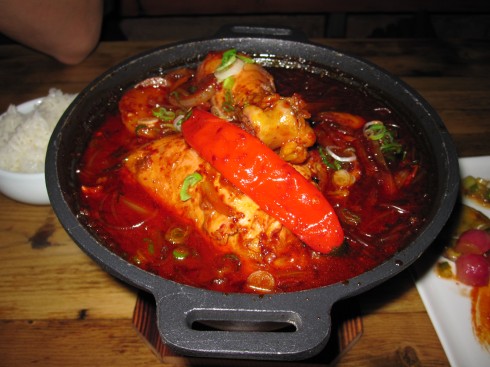
by Stephanie Dickison
Usually when you think of Turkey, you think of Turkish Coffee.
I think the perception is that it is similar to Greek coffee in that it is strong, as well as thick.
Nope, just thick. Turks get their caffeine from tea, funnily enough.
Here in Toronto, many Turkey dishes are readily available – Doner Kebap, Koftes, Baklava, Borek (flaky pies filled with meat, cheese or potatoes) – but I am fascinated by one of their breads called Pide. It looks like a cross between a french loaf and pita bread.
Here is a Turkish Pide Bread Recipe from Epicurean.com.
Ingredients:
4 teaspoons active dry yeast
1/2 teaspoon sugar
1/2 cup warm water
1/2 cup unbleached all-purpose flour
3 1/2 cups bread flour
1 teaspoon salt
3 tablespoons olive oil
1 cup plus 1 tablespoon lukewarm water
2 eggs, lightly beaten
Nigella seeds and/or sesame seeds
Directions:
Dissolve the yeast and sugar in warm water and let stand in a warm place for 10 minutes, until frothy. Stir in the flour, cover with plastic wrap, and let rise 30 minutes.
To finish the dough, put the flour in a large bowl, made a well in the center, and put in the sponge, salt, olive oil, and lukewarm water. Gradually work in the flour to make a soft and sticky dough. Knead the dough on a floured surface for 15 minutes. The dough will be very sticky at first, but as you knead, it will gradually cease to stick to your hands. You should have a damp and very springy dough that will offer no resistance to kneading. Put the dough in a buttered bowl, cover with plastic wrap, and let rise 1 hour, until well swollen.
You can refrigerate the dough at this point until you are ready to use it. To shape the pide, divide the dough into 2 pieces and shape each into a ball. Cover with a towel and let rest 30 minutes. Preheat the oven to 550 degrees, and heat the quarry tiles 30 minutes before baking. Flatten one piece of dough slightly. Wet your hands, press and enlarge the dough outward into a circle. Stretch out the circle, pressing hard, particularly with the sides of your hands.
When the dough is stretched to a 10-inch circle, paint it generously with egg. Using the sides of your hands, mark a border 2 inch wide all around the edge. Dip your fingertip in egg; holding your hands above the circle, 4 fingertips pointing down, mark 4 horizontal rows of indentationsparallel to each other with your fingertips, staying within the border. Rotate the circle halfway (180 degrees) and mark 4 rows of indentations parallel to each other and perpendicular to the previous rows. Let your fingertips go down deep, stopping short of piercing the dough. Sprinkle a wooden paddle with some flour. Lift the pide, holding it at both ends, and stretch it into an oval shape while placing it over the paddle.
How it should measure approximately 9 by 15 inches. Make sure it is well brushed with egg and sprinkle it with some nigella seeds or sesame seeds. Slide it gently onto the hot tiles and bake 6 to 8 minutes. As it comes out of the oven, keep it in the folds of a towel. Repeat with the remaining dough. Pide will be at its best fresh from the oven, but can be reheated in foil if necessary.
Makes two large loaves.
Binnur’s Turkish Cookbook has a recipe for Spinach Pide, which is making me drool all over my keyboard.
Here are some places to discover Turkish cuisine in Toronto:
Anatolia Traditional Turkish Cuisine – 5112 Dundas St. W.
Cafe Istanbul -1440 Bathurst St.
Champion Kokorech – 980 Danforth Ave.
Levante’s Gourmet Kebaps -1406 Yonge St.
Pizza Pide Restaurant -949 Gerard St. E.
Turkish Delights Istanbul -444 Yonge St.
Tags: baklava, borek, caffeine, cheese potatoes, doner kebap, flaky, french loaf, Greek, Greek coffee, kotes, meat, pide, pies, pita bread, spinach, strong, tea, thick, Toronto, turkey, Turkish coffee, Turkish cuisine






 By Chris Garbutt
By Chris Garbutt


Recent Comments